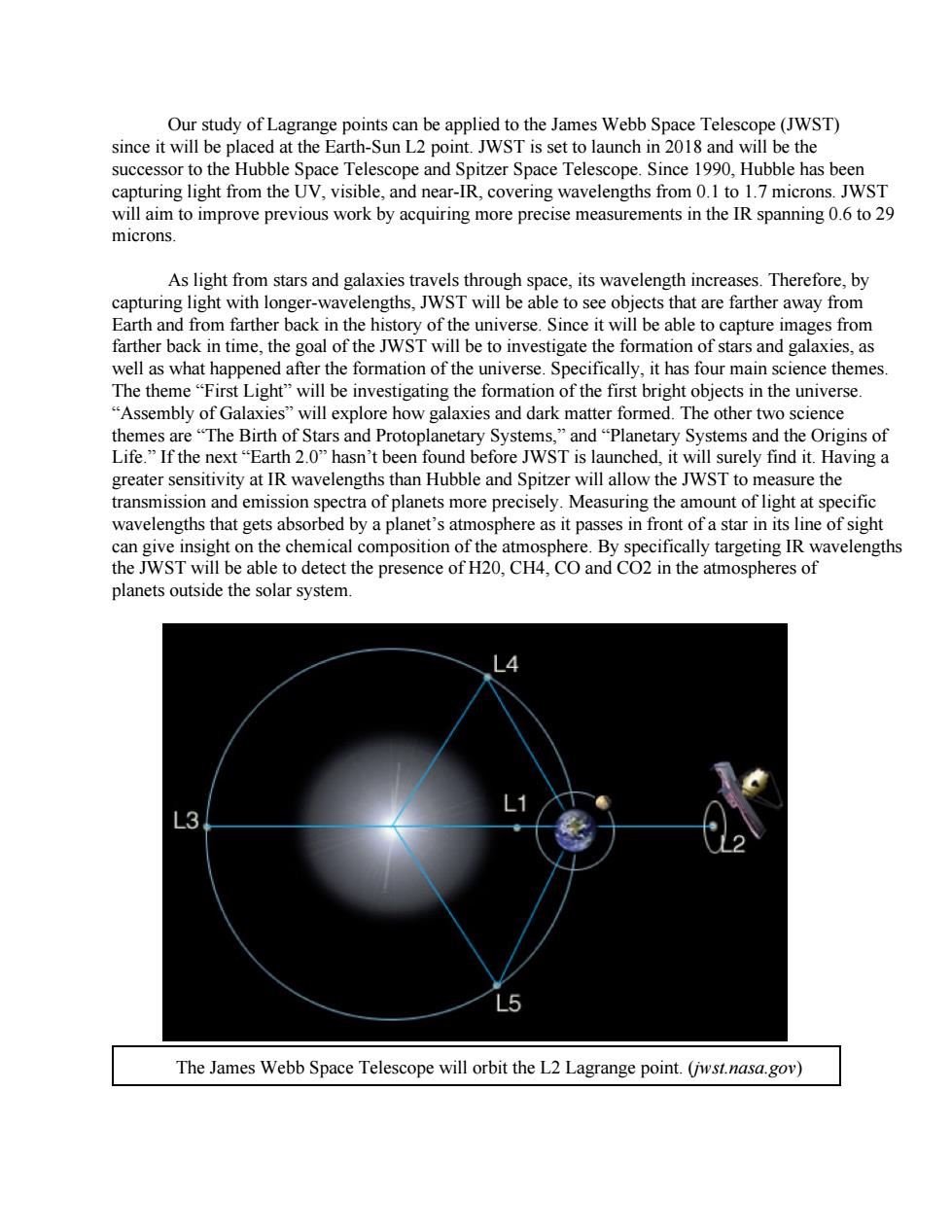正在加载图片...

Our study of Lagrange points can be applied to the James Webb Space Telescope(JWST) since it will be placed at the Earth-Sun L2 point.JWST is set to launch in 2018 and will be the successor to the Hubble Space Telescope and Spitzer Space Telescope.Since 1990,Hubble has been capturing light from the UV,visible,and near-IR,covering wavelengths from 0.1 to 1.7 microns.JWST will aim to improve previous work by acquiring more precise measurements in the IR spanning 0.6 to 29 microns. As light from stars and galaxies travels through space,its wavelength increases.Therefore,by capturing light with longer-wavelengths,JWST will be able to see objects that are farther away from Earth and from farther back in the history of the universe.Since it will be able to capture images from farther back in time,the goal of the JWST will be to investigate the formation of stars and galaxies,as well as what happened after the formation of the universe.Specifically,it has four main science themes. The theme"First Light"will be investigating the formation of the first bright objects in the universe. "Assembly of Galaxies"will explore how galaxies and dark matter formed.The other two science themes are "The Birth of Stars and Protoplanetary Systems,"and"Planetary Systems and the Origins of Life."If the next"Earth 2.0"hasn't been found before JWST is launched,it will surely find it.Having a greater sensitivity at IR wavelengths than Hubble and Spitzer will allow the JWST to measure the transmission and emission spectra of planets more precisely.Measuring the amount of light at specific wavelengths that gets absorbed by a planet's atmosphere as it passes in front of a star in its line of sight can give insight on the chemical composition of the atmosphere.By specifically targeting IR wavelengths the JWST will be able to detect the presence of H20,CH4,CO and CO2 in the atmospheres of planets outside the solar system. L3 5 The James Webb Space Telescope will orbit the L2 Lagrange point.(wst.nasa.gov)Our study of Lagrange points can be applied to the James Webb Space Telescope (JWST) since it will be placed at the EarthSun L2 point. JWST is set to launch in 2018 and will be the successor to the Hubble Space Telescope and Spitzer Space Telescope. Since 1990, Hubble has been capturing light from the UV, visible, and nearIR, covering wavelengths from 0.1 to 1.7 microns. JWST will aim to improve previous work by acquiring more precise measurements in the IR spanning 0.6 to 29 microns. As light from stars and galaxies travels through space, its wavelength increases. Therefore, by capturing light with longerwavelengths, JWST will be able to see objects that are farther away from Earth and from farther back in the history of the universe. Since it will be able to capture images from farther back in time, the goal of the JWST will be to investigate the formation of stars and galaxies, as well as what happened after the formation of the universe. Specifically, it has four main science themes. The theme “First Light” will be investigating the formation of the first bright objects in the universe. “Assembly of Galaxies” will explore how galaxies and dark matter formed. The other two science themes are “The Birth of Stars and Protoplanetary Systems,” and “Planetary Systems and the Origins of Life.” If the next “Earth 2.0” hasn’t been found before JWST is launched, it will surely find it. Having a greater sensitivity at IR wavelengths than Hubble and Spitzer will allow the JWST to measure the transmission and emission spectra of planets more precisely. Measuring the amount of light at specific wavelengths that gets absorbed by a planet’s atmosphere as it passes in front of a star in its line of sight can give insight on the chemical composition of the atmosphere. By specifically targeting IR wavelengths the JWST will be able to detect the presence of H20, CH4, CO and CO2 in the atmospheres of planets outside the solar system. The James Webb Space Telescope will orbit the L2 Lagrange point. (jwst.nasa.gov)